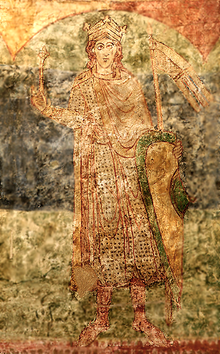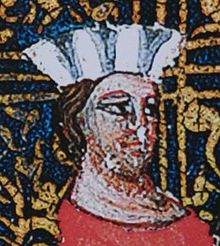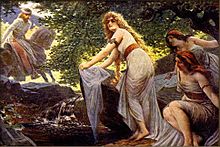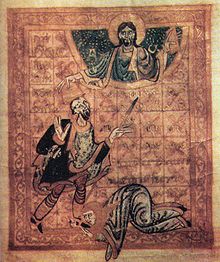
Adelaide of Hungary (c. 1040 – 27 January 1062[1]) was the only daughter of King Andrew I of Hungary of the Árpád dynasty and Anastasia of Kiev.
Bretislav I (Czech: Břetislav I.; 1002/1005–10 January 1055), known as the "Bohemian Achilles", of the Přemyslid dynasty, was Duke of Bohemia from 1035 until his death.
Bretislav was the son of Duke Oldřich[1] and his low-born concubine Božena. As an illegitimate son could not obtain a desirable wife by conventional means, he chose to kidnap his future wife Judith of Schweinfurt (Czech: Jitka), a daughter of the Bavarian noble Henry of Schweinfurt, Margrave of Nordgau, in 1019 at Schweinfurt.

Judith of Schweinfurt (Czech: Jitka ze Schweinfurtu; before 1003 – 2 August 1058) was Duchess consort of Bohemia from 1034 until 1055, by her marriage with the Přemyslid duke Bretislav I.[1]
Her parents were Henry of Schweinfurt (d. 1017), margrave in the Bavarian Nordgau,[1] and his wife Gerberga of Henneberg. Margrave Henry and his father Berthold may have been descendants of Duke Arnulf of Bavaria and related to the Luitpoldingdynasty. Berthold's brother (or nephew) Margrave Leopold I of Austria became progenitor of the Younger House of Babenberg. She was raised at the nunnery her family had founded in Schweinfurt.

Oldřich (Latin: Odalricus, Udalrichus, German: Odalric, Udalrich; c. 975 – 9 November 1034), a member of the Přemyslid dynasty, was Duke of Bohemia from 1012 to 1033 and briefly again in 1034. His accession to the Bohemian throne marked the start of a phase of stability after a long period of internal dynastic struggles. Under his rule, the Moravian lands were reconquered from Polishoccupation.
Oldřich was the third son of Duke Boleslaus II of Bohemia (d. 999) and one of his father's two wives: Adiva or Emma of Mělník

Božena (Křesinová) (died after 1052) was the second wife (and probably earlier the mistress) of Duke Oldřich of Bohemia and mother of Bretislaus I of Bohemia.

Boleslaus II the Pious (Czech: Boleslav II. Pobožný; c. 930 - 7 February 999), a member of the Přemyslid dynasty,[1] was Duke of Bohemia from 972 until his death
Boleslaus was an elder son of Duke Boleslaus I the Cruel and brother of the three other children of his father who survived to adulthood: Strachkvas, Dobrawa (the wife of Duke Mieszko I of Poland) and the abbess Mlada.[2] His mother may have been Biagota, a mysterious figure known only known from her coins. According to some historians, she was the wife of Boleslaus I.[7

Emma (Hemma) (b. before 950, d. 1005/06) was a Bohemian duchess consort as the second wife of Boleslaus II of Bohemia.
Her origins are uncertain. Historian Gelasius Dobner (1719–1790) thought she was a princess of Burgundy, and this theory has been recently respected. However the latest research of historians and numismatics indicate that she was of Italian-Burgundian origin and identified with Queen Emma of France (Emma of Italy), widow of King Lothair of France (d. 986). She became the second or wife of Boleslaus II about the year 989 and died either in 1005 or 1006. It was traditionally supposed by Czech historians that Emma was the mother of Boleslaus' younger sons Oldřich and Jaromír and that the mother of the oldest son, Boleslaus III of Bohemia, was Adiva, the first wife of Boleslaus II.

Boleslaus I the Cruel, also called Boleslav I (Czech: Boleslav I. Ukrutný) (c. 915 – 15 July, 967 or 972), was the ruler (kníže, "duke" or "prince") of the Duchy of Bohemia from 935 to his death. He was the son of Vratislaus I and the younger brother of his predecessor, Wenceslaus I.

Biagota was probably the wife of duke Boleslaus I of Bohemia.
Michal Lutovský writes in his book Bratrovrah a tvůrce státu (Fratricide and country-maker) that only a few coins confirm the existence of Biagota.
These coins are considered the oldest type of Přemyslid denar. An inscription can be read on them, BIAGOTACOIIIIX or BIAGOTACOVIIX, meaning BIAGOTA CONIVNX: wife Biagota. Possibly these coins were made on the occasion of marriage, but there is no proof for it.
It is not even sure that Biagota was the mother of all four adult children of Boleslaus I (Dobrawa, Boleslaus II of Bohemia, Strachkvas and Mlada of Bohemia). Her origins are unclear. She could have originated from one of the German states of the Holy Roman Empire or from a Slavic country (Blahota or Bjegota was an old Bulgarian name). Both hypotheses could be right, corresponding to the contemporary practice of European rulers.
Vratislaus (or Wratislaus) I (Czech: Vratislav I.; c. 888 – 13 February 921), a member of the Přemyslid dynasty, was Duke of Bohemia from 915 until his death. He was a son of Duke Bořivoj I of Bohemia by his wife Ludmila

Drahomíra of Stodor (Czech: Drahomíra ze Stodor; c. 877 or 890 – died after 934 or 936) was Duchess consort of Bohemia from 915 to 921, wife of the Přemyslid duke Vratislaus I. She also acted as regent of the Duchy of Bohemia from 921 to 924 during the minority of her son Wenceslaus. She is chiefly known for the murder of her mother-in-law Ludmila of Bohemia by hired assassins. Her name pronounced as "druh-haw-mee-ruh".
Drahomíra was born in the present-day Havelland region centered around the fortress of Brandenburg (Brennabor), the daughter of a Hevelli (Stodoran) prince.

Bořivoj I (Czech pronunciation: [ˈbɔr̝ɪvɔj], Latin: Borzivogius, c. 852 – c. 889) was the first historically documented Duke of Bohemiaand progenitor of the Přemyslid dynasty.[1] His reign over the Duchy of Bohemia is believed to have started about the year 870, but in this era was subordinated to Great Moravia. One of the most important clues to the approximate time of his accession is the contemporary Frankish chronicle Annales Fuldenses, which mentions several West Slavic princes in the year 872, among them one Goriwei, who may be identical with Bořivoj.
According to the early 12th-century Chronica Boëmorum, Bořivoj was a son of the legendary Bohemian prince Hostivít, thus a descendant of Queen Libuše and her husband Přemysl the Ploughman. His ancestry has not been conclusively established by historians, however. In view of his dependence on Great Moravia, he might have been related by blood to the Mojmir dynasty.

Saint Ludmila (c. 860 – 15 September 921) is a Czech saint and martyr venerated by the Orthodox and the Roman Catholics. She was born in Mělník as daughter of a Sorbian prince Slavibor.[1] Saint Ludmila was the grandmother of Saint Wenceslaus, who is widely referred to as Good King Wenceslaus.

Hostivít was the last of the seven Bohemian mythical princes between the (also mythical) founder of the Přemyslid dynasty Přemysl the Ploughman and the first historical prince Bořivoj. The names of the princes were first recorded in Cosmas chronicle and then transmitted into the most of historical books of the 19th century including František Palacký's The History of the Czech Nation in Bohemia and Moravia. According to tradition, he was the father of the non-legendary prince Bořivoj. Some historians suppose that when St. Ludmila was born, Hostivít (or Svatopluk I of Moravia) and Ludmila's father, Slavibor, contracted that Bořivoj and Ludmilla would get married (that can refer to the wedding procession of an unknown bride mentioned in Annales Fuldenses for 871.[1] According to the Chronicle of Dalimil, Hostivít had a brother called Děpolt who inherited the land of Kouřim.[2]
One theory about the number of the princes is propped on the frescoes on the walls of the Rotunda in Znojmo, Moravia but Anežka Merhautová claimed that the frescoes depict all the members of the Přemyslid dynasty including the Moravian junior prince
No hay comentarios:
Publicar un comentario